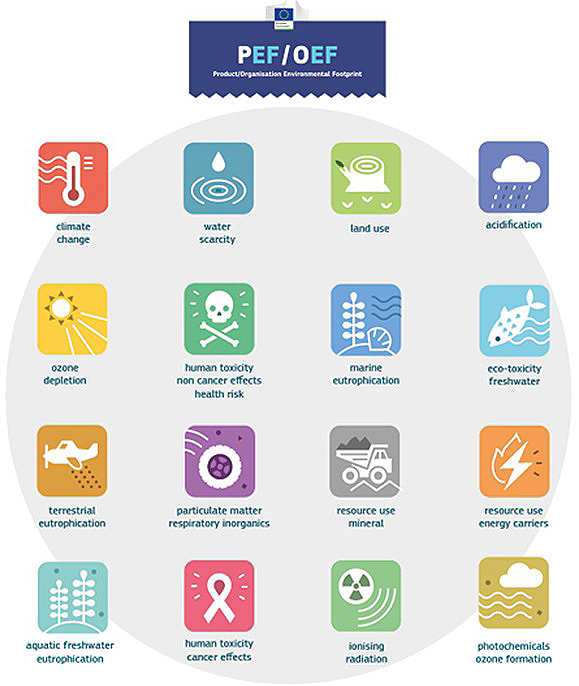
26 March 2024
The Strategic Value of OEF in Corporate Sustainability Initiatives
The Organization Environmental Footprint, or OEF, changes the way companies view their impact on the environment. This concept, born from the European Commission’s research, provides a uniform way to evaluate an organization’s environmental effects comprehensively, with the main goal to ensure comparability.
Traditional metrics might zoom in on just one area, like carbon emissions or how much water is used. However, the OEF method looks at a wider array of impacts. This not only includes the usual suspects like greenhouse gasses and water but also considers things like how resources are used up and how much waste is generated, from the start of production to the very end.
Let’s dive into what OEF and organization environmental footprint sector rules (OEFSR) really mean and its link to LCA. Find out how it reshapes business sustainability standards—keep reading to explore the impact and opportunities.
Table of Contents:
1. Understanding the Fundamentals: OEF Concept and Methodology Explained
2. Leveraging OEF for Enhanced Corporate Sustainability
3. Introduction to Sector-Specific Standards: Organization Environmental Footprint Sector Rules (OEFSR)
4. Conclusion: Embracing OEF for Future-Proof Corporate Environmental Strategy
Understanding the Fundamentals: OEF Concept and Methodology Explained
The Environmental Footprint for Organizations assesses the ecological impact of their operations in producing or providing goods and services, considering every stage of the entire lifecycle. This method involves multiple criteria to evaluate environmental performance. Additionally, the OEF methodology extends to assessing the environmental impact within supply chains, underlining its holistic approach.
The OEF aligns with the already well-known Product Environmental Footprint (PEF) approach, established by the European Commission. The introduction of the OEF aims to provide a unified standard within the Life Cycle Assessment (LCA) community, just like the PEF methodology.
The integration of the OEF and PEF methods signals a significant advance towards comprehensive environmental accountability, promoting sustainability across global markets.
While not mandatory and still in the transition phase, the OEF can be a valuable tool for organizations that want to demonstrate their commitment to sustainability. The OEF evaluates various environmental impact categories (16 impact categories), including carbon emissions, water usage, waste creation, and air pollution, offering a complete picture of a company’s environmental actions.
Above all, it helps businesses pinpoint where they’re having the biggest environmental impact, set clear goals for getting better, and share their journey with others. In turn, this can boost their reputation and build more trust with their customers and the wider community.

Key Steps in Conducting OEF Assessment
As mentioned before, the OEF’s method is founded on the principles of life cycle assessment (LCA), which looks at the environmental effects from all stages of a product’s life or an organization’s operations. The clear set of steps for conducting an Organization Environmental Footprint (OEF) are as follows: they mirror the procedures used for a Product Environmental Footprint (PEF), with the key distinction being that the OEF applies to an entire service over a full year, as opposed to a single product:
- Goal and Scope Definition
Here, we define what the study will cover and which organizational activities will be analyzed, thereby setting the stage for the entire environmental footprint evaluation. - Life Cycle Inventory (LCI)
In this step, we collect detailed data on all inputs and outputs from the organization’s operations. This is crucial for accurately assessing the environmental impact. - Life Cycle Impact Assessment (LCIA)
This phase translates the collected data into potential environmental impacts (cfr. 16 different impact categories under the OEF method). This step is crucial in identifying the most significant environmental challenges linked to your business - Interpretation
The final step is all about analyzing the results and translating them into clear, actionable strategies to improve your environmental performance.
Leveraging OEF for Enhanced Corporate Sustainability
Incorporating the Organization Environmental Footprint (OEF) into your organization’s sustainability strategy can offer numerous benefits. Let’s explore how businesses can potentially benefit from OEF:
- Strategic decision-making: The OEF helps to identify the environmental hotspots and areas of significant environmental impact. Allowing companies to focus their efforts where they can have the biggest positive impact.
- Boosting efficiency: By examining all areas of operation, OEF can point out where companies are wasting resources. Identifying these areas often leads to better environmental results and can also save money. For example, discovering high energy use might lead to investing in more efficient processes.
- Stakeholder communication: Sharing your sustainability efforts, like OEF results, with stakeholders like customers, investors, and government agencies shows a company’s commitment to cutting down environmental harm. It offers a clear and consistent way to talk about a company’s environmental efforts.
- Setting Benchmarks and Goals: OEF can help companies see how they stack up against industry standards or regulatory requirements. This comparison can help set achievable, clear environmental goals.
- Regulatory Compliance and Market Access: Following the OEF can help companies meet environmental laws and gain access to new markets, especially in places where green credentials are important to consumers and businesses.
Introduction to Sector-Specific Standards: Organization Environmental Footprint Sector Rules (OEFSR)
The issue lies in the fact that the standard rules of the Organization Environmental Footprint (OEF) do not ensure a consistent method for modeling products or organizations. Consequently, there is a need for additional guidelines to achieve a clear and uniform modeling approach across all organizations.
This is where the Organization Environmental Footprint Sector Rules (OEFSR) come into play, providing industry-specific directions. These rules aid in the precise modeling of organizational processes, including the analysis of both downstream and upstream activities. Whether for the organization itself or a comparable entity. Within the OEF methodology, the primary measure is the reporting entity of the organization. Which might encompass a range of products within a specific financial year.
The Organisation Environmental Footprint Sector Rules (OEFSR) parallels the PEFCR, in a certain way. The OEFSR provides a distinct and standardized framework for calculating an organization’s environmental performance within a specific industry. Furthermore, it facilitates the evaluation and benchmarking of environmental impacts either among different organizations or within a single organization over successive periods.
Currently, there are two Organization Environmental Footprint Sector Rules (OEFSR), the OEFSR Retail and OEFSR Copper Production. Let’s take a closer look at those two specific sectoral rules.
Organization Environmental Footprint Sector Rules (OEFSR) Retail
The OEFSR Retail provides a framework for retailers of all sizes, from small independent stores to large supermarket chains, to assess their environmental footprint. It covers the entire life cycle of products – everything from food to electronics – offered for personal or professional use. By evaluating the impact of their operations, from manufacturing to sales, retailers can understand and improve their overall environmental performance.
The OEFSR retail guidance is particularly aimed at those in the retail sector, including those who produce their own goods, ensuring they adhere to specific industry standards for sustainability. Here you can find the guidelines of OEFSR Retail from 2018.
Organization Environmental Footprint Sector Rules (OEFSR) Copper Production
The OEFSR of Copper Production is aimed at guiding companies involved in different stages of copper creation. Starting from mining raw materials to producing finished copper products like cathodes, anodes, and others.
It covers a range of associated products too, such as sulphuric acid and metals like silver and gold, all identified under specific industry codes (cfr. NACE codes). This guidance focuses on the pyrometallurgical route (a method of extracting metals by heating), excluding hydrometallurgical route (which involves dissolving minerals in water).
The OEFSR copper production is designed for both individual sites and larger organizations with multiple locations, detailing how to assess environmental impacts right from the beginning of the production process (the “cradle”) up to the point just before the product reaches the consumer (the “gate”), excluding the use and end-of-life stages due to the varied applications and recycling potentials of copper products.
This framework helps copper producers to not only report on their standard product portfolio but also on additional products, provided they detail the environmental impacts separately for a comprehensive view. Here you can find the guide from 2020.
Conclusion: Embracing OEF for Future-Proof Corporate Environmental Strategy
In summary, the Organization Environmental Footprint (OEF) offers a method for companies looking to calculate and improve their environmental sustainability. By adopting the Organization Environmental Footprint (OEF) framework, businesses can conduct a comprehensive evaluation of their environmental performance throughout every stage of their service lifecycle. This enables them to identify and implement the necessary measures to mitigate their environmental impact effectively
This not only aligns with global sustainability trends but also fosters transparency, efficiency, and regulatory compliance, ultimately strengthening corporate reputation in an increasingly eco-conscious market.
As the world moves towards a more sustainable future, integrating OEF into corporate strategies emerges as a strategic necessity. Especially for forward-thinking organizations seeking to lead in environmental stewardship and operational excellence. While the OEF is currently in a transition phase, with only two OEFSRs available so far. We’re looking forward to discovering what lies ahead.
Pilario offers a straightforward way to deal with the intricate details of PEF and PEFCR. This dedicated SaaS platform provides companies with ready-made, compliant LCA models tailored for various sectors. But Pilario does more than just simplify PEF compliance; it embeds sustainability into the very heart of your business approach and strategy.
Ready to dive deeper and transform your approach? Schedule your meeting with our experts today and unlock the full potential of Pilario. Start your journey to innovation and sustainability now!